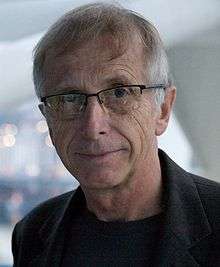Archie Brain
Archie I J Brain
 Archie Brain in 2009 | |
|---|---|
| Born |
July 2, 1942 Kobe, Japan |
| Nationality | British |
| Fields | Anaesthesia |
| Alma mater | University of Oxford |
| Known for | Inventor of laryngeal mask airway |
Archie Brain (born 1942) is a British anaesthetist best known as the inventor of the laryngeal mask . The LMA™ has been used over 300 million times worldwide in elective anaesthesia and emergency airway management.
Biography
Archie Ian Jeremy Brain, born in Kobe, Japan, July 2, 1942. Brain's father, Henry Norman, came from a middle-class family, studied at Oxford University and went on to work for the Foreign Office. Brain's father was a gifted musician and linguist (fluent in Japanese, Italian, French and Spanish) and spent 13 years in Japan, first as an interpreter and later as British Consul in Kobe. The family was interned at the outbreak of war, but in mid-August 1942, when Archie was only 6 weeks old, they were released and evacuated via a ship operated by the Red Cross. After the war, Henry Brain was promoted to British Ambassador to Cambodia (1957) and then to Uruguay (1961). Archie Brain's mother, Nuala Gertrude, was an Irish painter. Thirty years later, Henry Brain was still using his skills as a linguist and host, but this time to entertain Japanese anaesthetists visiting London who were interested in his son's curious invention. Henry Brain was knighted in 1961. Archie Brain had one brother, Quentin, who in addition to having muscular dystrophy, contracted polio in Singapore in the late 1940s and died in 1962.
At school, Archie Brain had a reputation as an athlete and a poet with little or no scientific ability. Nevertheless he found physics fascinating, and after being taught about electromagnetic fields, designed from scratch a schematic for an electric motor. Brain's ability for construction was apparent at an early age when, as a 14-year-old, he built his own guitar. He was not the first member of the family to invent anything. His Uncle Beric, who died of pneumonia in his twenties, invented one of the first radio valves.
After completing school, Brain won a scholarship to Oxford to read modern languages (French and Spanish). Brain would have preferred to study science but his teachers, who recognised his natural flair for modern languages, had discouraged him. A diplomat, Brain's father was keen for Archie to enter the diplomatic service but Brain decided to go to medical school. He was accepted at Oxford University where he took his preclinical exams and then went to St Bartholomew's Hospital in London for his clinical training from where he graduated in 1970. He began his anaesthetic training at the Royal East Sussex Hospital in November 1971. In 1973, when only 31 years old, he was offered a permanent post in a brand-new 600-bed hospital in the Netherlands as the Head of Department after doing a locum there - the kind of challenge he rose to with relish.
Four years later, he was offered a position working as an anesthetist for the Seychelles Government under the auspices of the Overseas Development Agency - another challenge he found impossible to refuse. Brain arrived in the capital, Victoria (population ~50,000), in April 1978 and found himself working mostly solo in the main hospital, which, at that time, had no intensive care unit and fairly primitive investigative resources. Despite this, he successfully anaesthetised a patient undergoing a mitral valvotomy for Dr Christiaan Neethling Barnard, the first surgeon to perform a heart transplant, who was on a charity visit. He also anaesthetised the painter Michael Adams who was famous for his portrait of the British Royal Family. When not at work he composed music, explored the surrounding reefs and enjoyed time with his first daughter, Natasha, who was born in 1979.[1]
Brain returned to the UK in April 1980 and took up a post as a lecturer at the Royal London Hospital under Professor Jimmy Payne. Shortly after, he had his first taste of research when he set out to determine the electromagnetic field strength required to block the action potential along a nerve. This involved encircling a frog nerve-muscle preparation with an electromagnetic coil.[2] In 1982, he had his first publication: a letter to the editor suggesting that alcuronium should be used instead of succinylcholine for "crash" induction.[3]
It was during this period that Brain's flair for designing medical equipment first became apparent. In fact, his inventiveness was so intense that by late 1981 he had designed, built, and submitted patent applications for 12 new devices, including one to assist venepuncture, one to prevent obstruction of anaesthetic trolleys by cables, one to apply a specific amount of cricoid pressure, and even a rotating bed for use in intensive care to prevent bed-sores. The laryngeal mask, LMA Classic™ was his 13th patent application and was granted in 1982.[4]
References
- ↑ Joseph R. Brimacombe, Laryngeal Mask Airway: Principles and Practice, Second Edition (2005), pp. 10-11.
- ↑ Wali FA, Brain AIJ. Inhibition of nerve conduction by electromagnetic induction of the frog sciatic nerve - gastrocnemius muscle preparation. Jap J Physiol 1989;39:303-310.
- ↑ Brain AI. The rapid induction tecnique for Caesarean section. Anaesthesia 1982;37:345.
- ↑ Joseph R. Brimacombe, Laryngeal Mask Airway: Principles and Practice, Second Edition (2005), pp. 10-11.
Further reading
- Joseph R. Brimacombe, Laryngeal Mask Airway: Principles and Practice, Second Edition, Saunders, 2005. ISBN 0-7020-2700-6